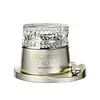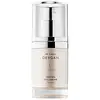What's inside
What's inside
 Key Ingredients
Key Ingredients

 Benefits
Benefits

 Concerns
Concerns

 Ingredients Side-by-side
Ingredients Side-by-side

Water
Skin ConditioningButylene Glycol
HumectantHydrogenated Lecithin
EmulsifyingGlycerin
HumectantPolyglyceryl-2 Triisostearate
EmulsifyingPhytosteryl/Behenyl/Octyldodecyl Lauroyl Glutamate
Skin ConditioningCetearyl Alcohol
EmollientHydrogenated Castor Oil Stearate
Skin ConditioningDipentaerythrityl Hexahydroxystearate/Hexastearate/Hexarosinate
Skin ConditioningBetula Platyphylla Japonica Juice
Skin ConditioningHydrogenated Polyisobutene
EmollientCetyl Palmitate
EmollientDimethicone
EmollientPropylene Glycol Dicaprate
EmollientAcanthopanax Senticosus Root Extract
Skin ConditioningAcetyl Hexapeptide-8
HumectantAcorus Calamus Root Extract
PerfumingAdenosine
Skin ConditioningAscorbyl Tetraisopalmitate
AntioxidantBetula Platyphylla Japonica Bark Extract
Skin ConditioningCamellia Sinensis Leaf Extract
AntimicrobialEugenia Caryophyllus Flower Extract
AstringentHydrolyzed Collagen
EmollientHydrolyzed Soybean Extract
Skin ConditioningIsodonis Japonicus Leaf/Stalk Extract
MaskingJania Rubens Extract
Skin ConditioningLactobacillus/Pear Juice Ferment Filtrate
Skin ConditioningLactobacillus/Soymilk Ferment Filtrate
Skin ConditioningMaltose
MaskingMentha Piperita Leaf Extract
Skin ConditioningMucuna Birdwoodiana Stem Extract
Skin ConditioningPalmitoyl Pentapeptide-4
Skin ConditioningSantalum Album Wood Extract
PerfumingTocopherol
AntioxidantTocotrienols
Skin ConditioningZiziphus Jujuba Fruit Extract
Skin ConditioningAlcohol
AntimicrobialAlgin
MaskingBeeswax
Emulsion StabilisingCarbomer
Emulsion StabilisingCholesterol
EmollientCholesteryl Oleate
Skin ConditioningDisodium Succinate
MaskingEthyl Oleate
EmollientGlycine Soja Sterols
EmollientLecithin
EmollientOleyl Alcohol
EmollientOryza Sativa Bran Oil
EmollientPhytosteryl Macadamiate
Skin ConditioningPhytosteryl Oleate
Skin ConditioningPhytosteryl/Octyldodecyl Lauroyl Glutamate
Skin ConditioningPoloxamer 407
EmulsifyingPolysorbate 20
EmulsifyingPPG-12/Smdi Copolymer
EmollientSodium Hydroxide
BufferingSodium Lactate
BufferingSodium Methyl Stearoyl Taurate
CleansingSorbitan Oleate
EmulsifyingSqualane
EmollientSuccinic Acid
BufferingPhenoxyethanol
PreservativePotassium Sorbate
PreservativeParfum
MaskingCaramel
Cosmetic ColorantWater, Butylene Glycol, Hydrogenated Lecithin, Glycerin, Polyglyceryl-2 Triisostearate, Phytosteryl/Behenyl/Octyldodecyl Lauroyl Glutamate, Cetearyl Alcohol, Hydrogenated Castor Oil Stearate, Dipentaerythrityl Hexahydroxystearate/Hexastearate/Hexarosinate, Betula Platyphylla Japonica Juice, Hydrogenated Polyisobutene, Cetyl Palmitate, Dimethicone, Propylene Glycol Dicaprate, Acanthopanax Senticosus Root Extract, Acetyl Hexapeptide-8, Acorus Calamus Root Extract, Adenosine, Ascorbyl Tetraisopalmitate, Betula Platyphylla Japonica Bark Extract, Camellia Sinensis Leaf Extract, Eugenia Caryophyllus Flower Extract, Hydrolyzed Collagen, Hydrolyzed Soybean Extract, Isodonis Japonicus Leaf/Stalk Extract, Jania Rubens Extract, Lactobacillus/Pear Juice Ferment Filtrate, Lactobacillus/Soymilk Ferment Filtrate, Maltose, Mentha Piperita Leaf Extract, Mucuna Birdwoodiana Stem Extract, Palmitoyl Pentapeptide-4, Santalum Album Wood Extract, Tocopherol, Tocotrienols, Ziziphus Jujuba Fruit Extract, Alcohol, Algin, Beeswax, Carbomer, Cholesterol, Cholesteryl Oleate, Disodium Succinate, Ethyl Oleate, Glycine Soja Sterols, Lecithin, Oleyl Alcohol, Oryza Sativa Bran Oil, Phytosteryl Macadamiate, Phytosteryl Oleate, Phytosteryl/Octyldodecyl Lauroyl Glutamate, Poloxamer 407, Polysorbate 20, PPG-12/Smdi Copolymer, Sodium Hydroxide, Sodium Lactate, Sodium Methyl Stearoyl Taurate, Sorbitan Oleate, Squalane, Succinic Acid, Phenoxyethanol, Potassium Sorbate, Parfum, Caramel
Water
Skin ConditioningHelianthus Annuus Seed Oil
EmollientGlycerin
HumectantDimethicone
EmollientIsopropyl Palmitate
EmollientPalmitoyl Tripeptide-1
Skin ConditioningPalmitoyl Tetrapeptide-7
Skin ConditioningSteareth-20
CleansingChrysin
Skin ConditioningN-Hydroxysuccinimide
Skin ConditioningButylene Glycol
HumectantCarbomer
Emulsion StabilisingPolysorbate 20
EmulsifyingGlycol Distearate
EmollientGlyceryl Stearate
EmollientPEG-100 Stearate
Stearic Acid
CleansingStearyl Alcohol
EmollientPhytonadione Epoxide
AstringentVitis Vinifera Seed Oil
EmollientPersea Gratissima Oil
Skin ConditioningTocopheryl Acetate
AntioxidantAllantoin
Skin ConditioningTitanium Dioxide
Cosmetic ColorantTetrasodium EDTA
Triethanolamine
BufferingPhenoxyethanol
PreservativeEthylhexylglycerin
Skin ConditioningWater, Helianthus Annuus Seed Oil, Glycerin, Dimethicone, Isopropyl Palmitate, Palmitoyl Tripeptide-1, Palmitoyl Tetrapeptide-7, Steareth-20, Chrysin, N-Hydroxysuccinimide, Butylene Glycol, Carbomer, Polysorbate 20, Glycol Distearate, Glyceryl Stearate, PEG-100 Stearate, Stearic Acid, Stearyl Alcohol, Phytonadione Epoxide, Vitis Vinifera Seed Oil, Persea Gratissima Oil, Tocopheryl Acetate, Allantoin, Titanium Dioxide, Tetrasodium EDTA, Triethanolamine, Phenoxyethanol, Ethylhexylglycerin
Ingredients Explained
These ingredients are found in both products.
Ingredients higher up in an ingredient list are typically present in a larger amount.
Butylene Glycol (or BG) is used within cosmetic products for a few different reasons:
Overall, Butylene Glycol is a safe and well-rounded ingredient that works well with other ingredients.
Though this ingredient works well with most skin types, some people with sensitive skin may experience a reaction such as allergic rashes, closed comedones, or itchiness.
Learn more about Butylene GlycolCarbomer is a polymer of acrylic acid. Its main role is to create a gel consistency.
A high amount of carbomer can cause pilling or balling up of products. Don't worry, most products contain 1% or less of carbomer.
Dimethicone is a type of synthetic silicone created from natural materials such as quartz.
What it does:
Dimethicone comes in different viscosities:
Depending on the viscosity, dimethicone has different properties.
Ingredients lists don't always show which type is used, so we recommend reaching out to the brand if you have questions about the viscosity.
This ingredient is unlikely to cause irritation because it does not get absorbed into skin. However, people with silicone allergies should be careful about using this ingredient.
Note: Dimethicone may contribute to pilling. This is because it is not oil or water soluble, so pilling may occur when layered with products. When mixed with heavy oils in a formula, the outcome is also quite greasy.
Learn more about DimethiconeGlycerin is already naturally found in your skin. It helps moisturize and protect your skin.
A study from 2016 found glycerin to be more effective as a humectant than AHAs and hyaluronic acid.
As a humectant, it helps the skin stay hydrated by pulling moisture to your skin. The low molecular weight of glycerin allows it to pull moisture into the deeper layers of your skin.
Hydrated skin improves your skin barrier; Your skin barrier helps protect against irritants and bacteria.
Glycerin has also been found to have antimicrobial and antiviral properties. Due to these properties, glycerin is often used in wound and burn treatments.
In cosmetics, glycerin is usually derived from plants such as soybean or palm. However, it can also be sourced from animals, such as tallow or animal fat.
This ingredient is organic, colorless, odorless, and non-toxic.
Glycerin is the name for this ingredient in American English. British English uses Glycerol/Glycerine.
Learn more about GlycerinPhenoxyethanol is a preservative that has germicide, antimicrobial, and aromatic properties. Studies show that phenoxyethanol can prevent microbial growth. By itself, it has a scent that is similar to that of a rose.
It's often used in formulations along with Caprylyl Glycol to preserve the shelf life of products.
Polysorbate 20 is made by combining ethoxylation of sorbitan, ethylene oxide, and lauric acid. It is a mild cleansing agent, surfactant, and emulsifier.
As a surfactant, it helps collect dirt and oils for washing. Emulsifiers prevent oils and water from separating.
Polysorbate 20 also adds scent to a product. Since it is made using sorbitol, it has a sweet scent. Sorbitol can also be found in fruits such as apples and peaches.
The lauric acid used to create Polysorbate 20 is often derived from coconuts.
Polysorbate 20 may not be fungal acne safe.
Learn more about Polysorbate 20Water. It's the most common cosmetic ingredient of all. You'll usually see it at the top of ingredient lists, meaning that it makes up the largest part of the product.
So why is it so popular? Water most often acts as a solvent - this means that it helps dissolve other ingredients into the formulation.
You'll also recognize water as that liquid we all need to stay alive. If you see this, drink a glass of water. Stay hydrated!
Learn more about Water